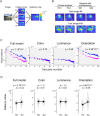Visual salience is affected in participants with schizophrenia during free-viewing
- PMID: 38409435
- PMCID: PMC10897421
- DOI: 10.1038/s41598-024-55359-0
Visual salience is affected in participants with schizophrenia during free-viewing
Abstract
Abnormalities in visual exploration affect the daily lives of patients with schizophrenia. For example, scanpath length during free-viewing is shorter in schizophrenia. However, its origin and its relevance to symptoms are unknown. Here we investigate the possibility that abnormalities in eye movements result from abnormalities in visual or visuo-cognitive processing. More specifically, we examined whether such abnormalities reflect visual salience in schizophrenia. Eye movements of 82 patients and 252 healthy individuals viewing natural and/or complex images were examined using saliency maps for static images to determine the contributions of low-level visual features to salience-guided eye movements. The results showed that the mean value for orientation salience at the gazes of the participants with schizophrenia were higher than that of the healthy control subjects. Further analyses revealed that orientation salience defined by the L + M channel of the DKL color space is specifically affected in schizophrenia, suggesting abnormalities in the magnocellular visual pathway. By looking into the computational stages of the visual salience, we found that the difference between schizophrenia and healthy control emerges at the earlier stage, suggesting functional decline in early visual processing. These results suggest that visual salience is affected in schizophrenia, thereby expanding the concept of the aberrant salience hypothesis of psychosis to the visual domain.
Keywords: Aberrant salience hypothesis; Saccades; Salience.
© 2024. The Author(s).
Conflict of interest statement
The authors declare no competing interests.
Figures




Similar articles
-
Gaze behaviors during free viewing revealed differences in visual salience processing across four major psychiatric disorders: a mega-analysis study of 1012 individuals.Mol Psychiatry. 2025 Apr;30(4):1594-1600. doi: 10.1038/s41380-024-02773-5. Epub 2024 Oct 11. Mol Psychiatry. 2025. PMID: 39394456 Free PMC article.
-
Aberrant Salience Is Related to Dysfunctional Self-Referential Processing in Psychosis.Schizophr Bull. 2016 Jan;42(1):67-76. doi: 10.1093/schbul/sbv098. Epub 2015 Jul 20. Schizophr Bull. 2016. PMID: 26194892 Free PMC article.
-
The effect of ketamine on eye movement characteristics during free-viewing of natural images in common marmosets.Front Neurosci. 2022 Sep 20;16:1012300. doi: 10.3389/fnins.2022.1012300. eCollection 2022. Front Neurosci. 2022. PMID: 36203813 Free PMC article.
-
New Insights into Schizophrenia: a Look at the Eye and Related Structures.Psychiatr Danub. 2020 Spring;32(1):60-69. doi: 10.24869/psyd.2020.60. Psychiatr Danub. 2020. PMID: 32303031 Review.
-
Free viewing exploration in schizophrenia: Review of evidence from laboratory settings to natural environment.Encephale. 2020 Apr;46(2):115-122. doi: 10.1016/j.encep.2019.11.012. Epub 2020 Feb 11. Encephale. 2020. PMID: 32057409 Review.
Cited by
-
Brainsourcing for temporal visual attention estimation.Biomed Eng Lett. 2025 Jan 11;15(2):311-326. doi: 10.1007/s13534-024-00449-1. eCollection 2025 Mar. Biomed Eng Lett. 2025. PMID: 40026891 Free PMC article.
-
Gaze behaviors during free viewing revealed differences in visual salience processing across four major psychiatric disorders: a mega-analysis study of 1012 individuals.Mol Psychiatry. 2025 Apr;30(4):1594-1600. doi: 10.1038/s41380-024-02773-5. Epub 2024 Oct 11. Mol Psychiatry. 2025. PMID: 39394456 Free PMC article.
-
Tablet-Based Cognitive and Eye Movement Measures as Accessible Tools for Schizophrenia Assessment: Multisite Usability Study.JMIR Ment Health. 2024 May 30;11:e56668. doi: 10.2196/56668. JMIR Ment Health. 2024. PMID: 38815257 Free PMC article.
References
MeSH terms
Grants and funding
LinkOut - more resources
Full Text Sources
Medical

